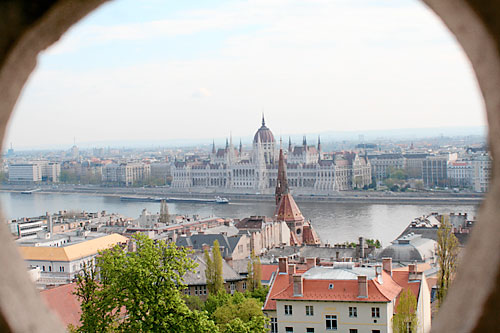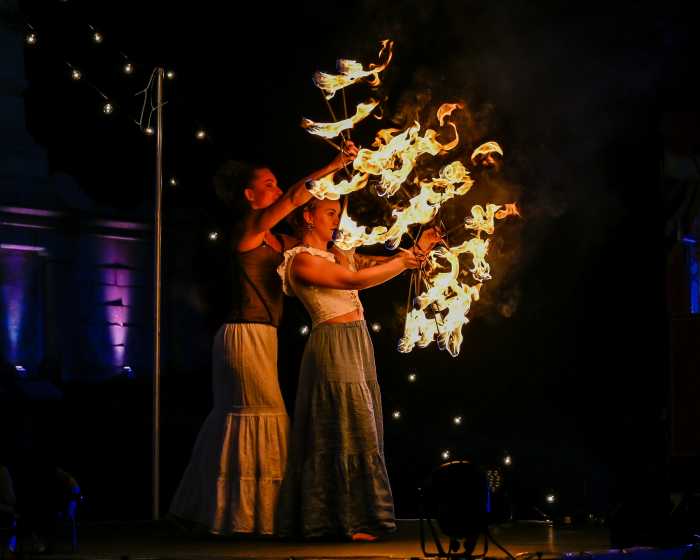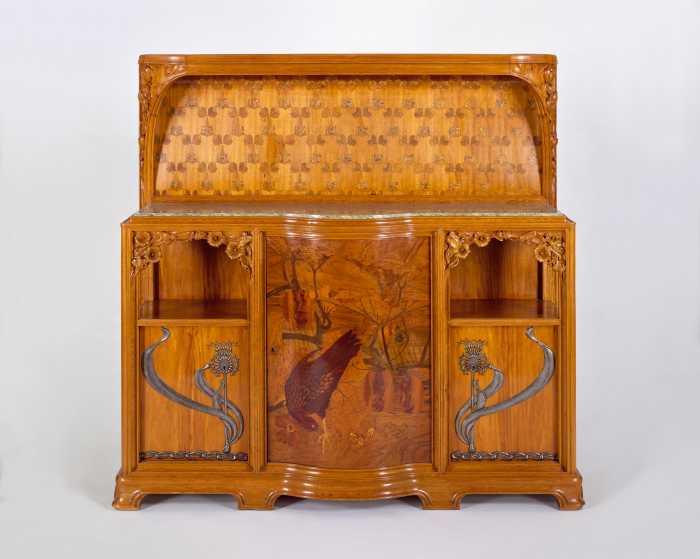Szia, Budapest!
American Airlines has just begun non-stop service to the Hungarian capital, making it easier for you to say “Hi” to the underappreciated jewel of Central Europe, the Danube bank sister cities of Buda and Pest.
Budapest offers Western European oppulence and civic style in a decidedly working-class Eastern European setting. The result is a city that feels as comfortable as Paris, but never feels like a museum piece frozen in time for the tourists. People live and work here — though there’s plenty for outsiders to see and do.
How about picture-perfect sights?
A city’s worth of stunning Art Nouveau architecture? Got that, too.
Dozens of hot thermal baths? A bus that turns into a boat and splashes right into the Danube? Yes and yes — plus gallons of cheap Hungarian wine.
Now the words “cheap Hungarian wine” may not motivate you to get on a plane, but they should. Even dedicated oenophiles are profoundly ignorant when it comes to one of Hungary’s major contributions to world culture (in addition to fighting off the Soviets!). Hungary has about a dozen wine-producing regions, many within a short drive of the capital, beckoning you with wineries and inns where you can sample the local fare, get a great meal, and then sleep it off.
The lay of the land
Budapest — pronounced (unpretentiously) Budapesht — consists of two urban portions straddling the Danube, Europe’s main west-east aquatic highway. On the west shore is Buda, the hilly, tree-filled, residential and castle district. On the east is Pest, the Paris-style area of offices, government agencies, nightclubs, theaters and city attractions.
It’s not a huge city — the population is only 1.7 million — and you can easily walk from City Park at the eastern end of Pest to the Danube and then up to Buda Castle in an hour. That walk, down Andrassy Ut, puts Budapest’s cosmopolitanism at your feet, with a host of Modernist architecture, plenty of Champs Elysee-style retail outlets, an opera house or two, and even a side street packed with the chic restaurants where the real Pestars go.
You need three days to take it all in — with our guide, of course:
Day 1: Buda
Start your stay by heading west to the hilly, historic side of town, home to the city’s castle district, old Roman ruins, Brooklyn-esque residential streets and the best views in town.
The best way to explore Buda is to walk from Pest over the Széchenyi Chain Bridge, the mini-Brooklyn Bridge-like span completed in 1849 that deposits you at 0 Km square — the spot from which all roadway measurements in Hungary are taken. From the square, take the 18th-century cog railway up to the palace. Once there, take in the view, and visit the castle district, with its history museum, library and national gallery. The scenic overlook across the Danube to the Parliament building on the Pest side is the spot from which all the postcard shots are taken.
Skip the tour of the castle’s labryinth, which is boring, and walk north into Vizivaros (Watertown), which has a great thermal bath dating back to the 1500s. And just to the north of that is Obuda, which hosts the ruins of the ancient Roman city of Aquincum.
By this point, you’ve walked around enough, so head back across the Chain Bridge to Roosevelt Square, where you can take the slightly cheesy, but very informative, Riverride bus-boat tour (www.riverride.com). No, a bus tour may not sound great, but cruising the streets of Pest with a guide provides a great overview — and then the bus plunges into the Danube itself for the last half-hour, providing a relaxing climax.
Day 2: Pest sights
Befitting a major world capital, Pest is home to a kick-ass Parliament building, the biggest synagogue in Europe, many impressive churches, and plenty of amazing buildings to just gawk at.

A good place to start is at the Parliament building itself [V Kossuth Lajos ter, 1-3, (1) 441-4905]. Completed in 1902, it was the victor in a design competition over two other also-impressive schemes; the runners-up were so good, in fact, that they were built across the street to house various agencies.
The main reason to visit Parliament is to see the Crown of St. Stephen up close, if only because it is the country’s national symbol — believed to be the crown that the Pope gave to St. Stephen in 1000 after he converted the pagans to Christianity. The bejeweled crown has a characteristic bent cross — the result of being dropped during its many periods in hiding during Hungary’s many periods of repression.
From Parliament, it’s easy to get to Bedo House [Honved u. 3, (1) 269-4622, www.magyarszecessziohaza.hu]. It’s not only one of the city’s classic Secessionist-style buildings, but it houses a collection of similarly Modernist furniture. And it has a good cafe for a jolt of espresso.
Just to the east is the Parisian-styled section of Pest, complete with the Opera House and other buildings that have long stood in for the French capital in movies.
When it’s time for lunch or dinner, you must stop in Franz Liszt Square, home to cafes and bars. A good choice is Menza [1061 Franz Liszt Square, (1) 413-1482, www.menzaetterem.hu], which offers a modern take on Hungarian food — and design.
Nearby is the essential House of Terror Museum [Andrássy út 60, (1) 374-2600 www.terrorhaza.hu/en], housed in the former headquarters of the secret police. It tells the Hungarian version of the age-old story of oppression, but it bears repeating.
Also in this area of town is the New York Palace Hotel [Erzsébet körút 9-11, (1) 886-6111, www.newyorkcafe.hu/eng], which is so sumptuous that a stop for only an espresso or a pastry is likely to keep you on budget. But a visit to the ground-floor coffeehouse, where writers once spent hours procrastinating, is a trip back to 19th-century Budapest.
Head back down Andrassy to visit the Great Synagogue [VII Dohany utca, 2-8, (1) 413-5500], the largest Jewish temple outside of New York City. It’ll probably come as no surprise that Nazi occupiers chose this building to be their local headquarters.
Day 3: Pest life
Begin this day by setting aside at least an hour at the Nagycsarnok, or Great Market, on the south side of town (IX Vamhaz korut, 1-3). Every European city has a massive, multi-stalled food center like this, but to understand Hungarian food and culture, this is a must. Who knew there were so many kinds of Hungarian sausage? Who knew there were more than two kinds of paprika? Who knew you could buy a chicken so fresh that it still has the eggs inside it?
Another vital stop on a day devoted to enjoying the real Budapest is a subway ride to City Park. Get off at Heroes Square — but only to take in a bizarre and oversized statuary tribute to the original Magyar tribesmen who founded Hungary in 897. The square is flanked by museums, but the real goal of this trip is Szecheny Baths (Állatkerti krt. 11, www.szechenyibath.com), where you can indulge in dozens of hot spring thermal pools with your fellow Budapestars and see firsthand that Soviet bathing apparel never seems to go out of style.
Another treat is a Hungarian cooking course at Essencia Cooking School (www.essencia.hu/english), which perfect as an entree into Hungarian culture, plus a great lunch break in the center of Pest.
And no tour of real Budapest is complete without a visit to one of the city’s “ruin pubs,” which, despite their name, don’t mean that you’ll be passing around Hungarian wine out in a paper bag huddled over a burning oil can. The name is closer in meaning to “unfinished,” and the result is pubs that have a delightfully thrown together feeling.
There’s Szimpla Kert (Kazinczy utca 14, www.szimpla.hu), a fashionable wreck near the old synagogue. And the younger crowd will love the bar atop the Soviet-era Corvin shopping center [Blaha Lujza square 1-2, (20) 772-2984, corvinteto.hu/en], a delightful throwback to Eastern Europe’s bunker mentality during the years before freedom — complete with the loud rock bands and beer in plastic cups.
The small print
American Airlines is the only major carrier with year-round non-stop service to Budapest. The airline offers specials as low as $385 (one way with Saturday night stay) or $989 for business class (for info, visit www.aa.com). Business travelers will like the Kempinski Hotel Corvinus [Erzsebet ter 7-8, (1) 429-3777] for its location and comfort. For info, visit www.kempinski.com/budapest.






















